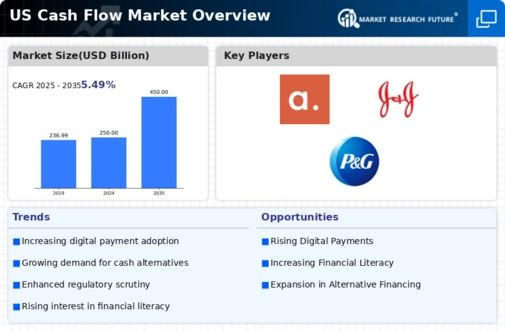Evolving Consumer Preferences
Consumer preferences are shifting significantly, impacting the cash flow market. As businesses increasingly prioritize customer experience, there is a growing demand for flexible payment options and seamless transaction processes. In 2025, approximately 45% of consumers are expected to prefer digital payment methods over traditional cash transactions. This trend is prompting companies within the cash flow market to innovate their payment solutions, ensuring they meet the evolving expectations of their clientele. Additionally, the rise of subscription-based models and on-demand services is influencing cash flow patterns, necessitating businesses to adopt more agile cash management strategies. Companies that can effectively respond to these changing preferences are likely to gain a competitive edge in the cash flow market, positioning themselves for sustained growth.
Economic Fluctuations and Market Volatility
Economic fluctuations and market volatility are critical drivers affecting the cash flow market. In 2025, the US economy is projected to experience moderate growth, with GDP increasing by approximately 2.5%. However, uncertainties such as inflation rates and geopolitical tensions may lead to unpredictable cash flow scenarios for businesses. Companies in the cash flow market must remain vigilant and adaptable to these economic changes, as they can significantly impact liquidity and financial stability. Businesses that proactively manage their cash flow in response to economic indicators are likely to mitigate risks associated with downturns. Moreover, organizations that leverage data analytics to forecast economic trends can enhance their cash flow management strategies, ensuring they remain resilient in the face of potential challenges.
Regulatory Changes and Compliance Requirements
The cash flow market is increasingly influenced by evolving regulatory changes and compliance requirements. In 2025, businesses are expected to face stricter regulations regarding financial reporting and cash management practices. Compliance with these regulations is essential for maintaining operational integrity and avoiding penalties. Companies that invest in robust compliance frameworks are likely to enhance their credibility and trustworthiness in the cash flow market. Furthermore, the implementation of new regulations may necessitate the adoption of advanced financial technologies to ensure accurate reporting and transparency. As regulatory landscapes continue to evolve, businesses that proactively adapt to these changes will likely position themselves favorably within the cash flow market, ensuring long-term sustainability.
Technological Advancements in Financial Services
The cash flow market is experiencing a notable transformation due to rapid technological advancements. Innovations such as artificial intelligence and machine learning are streamlining cash management processes, enhancing forecasting accuracy, and improving decision-making capabilities. In 2025, it is estimated that over 60% of businesses in the cash flow market will adopt automated solutions for cash flow forecasting. This shift not only reduces operational costs but also increases efficiency, allowing companies to allocate resources more effectively. Furthermore, the integration of blockchain technology is expected to enhance transparency and security in transactions, thereby fostering trust among stakeholders. As these technologies continue to evolve, they are likely to reshape the competitive landscape of the cash flow market, compelling traditional players to adapt or risk obsolescence.
Increased Focus on Sustainability and Ethical Practices
The cash flow market is witnessing a growing emphasis on sustainability and ethical business practices. In 2025, consumers and investors are increasingly prioritizing companies that demonstrate social responsibility and environmental stewardship. This shift is prompting businesses to reassess their cash flow strategies, ensuring they align with sustainable practices. Companies that adopt green financing options and invest in sustainable projects are likely to attract a more conscientious customer base. Additionally, organizations that transparently report their sustainability efforts may enhance their reputation and brand loyalty within the cash flow market. As the demand for ethical practices continues to rise, businesses that integrate sustainability into their cash flow management strategies are likely to gain a competitive advantage, positioning themselves as leaders in the evolving market landscape.














Leave a Comment